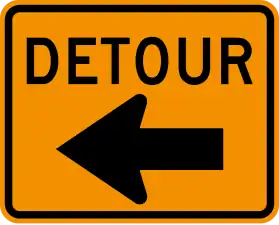Detour
A detour or (British English: diversion) is a (normally temporary) route taking traffic around an area of prohibited or reduced access, such as a construction site. Standard operating procedure for many roads departments is to route any detour over roads within the same jurisdiction as the road with the obstructed area.[1]

On multi-lane highways (e.g., freeways, expressways, city streets, etc.), usually traffic shifts can replace a detour, as detours often congest turn lanes.
Types
Depending on the roadway affected, and the scope of construction, different types of detours may be used. The most basic is to simply close a stretch of roadway for a defined period of time, diverting all traffic around the site. Other types of detours may also be used, such as a detour that is only in effect at night, only in effect during weekends, or a detour that restricts through traffic while permitting local traffic such as residents and delivery vehicles. Which type of detour to use is decided by a variety of factors – a full closure of a road means construction can be completed more quickly, but also means a more severe impact on traffic.[2]
Implementation
Detours require signage to notify drivers, especially those who are not local and are unfamiliar with the road network in an area.[3] Creating a detour imposes costs on motorists, along with wear and tear on the detour route. When a detour from a highway travels over local streets, they may first be reinforced to handle highway level traffic.[4]
Railroad detours

Detours may be used for trains as well. Implementing detours is more difficult for railroads, as rail networks do not have the many redundant pathways offered by road networks. Railroad detours are most commonly used when a significant natural disaster renders a railroad route inaccessible until it can be repaired, though they may also be used when a line is out of service for maintenance.[5]

In North America, the various railroad companies have agreed to cooperate when one company needs to detour its trains onto the tracks of a different company. The railroad detouring trains will arrange with the "host" railroad(s) how many trains a day will need to use a detour, and agree on the fee per train-mile the detouring company will pay in exchange.[5]

Permanently signed detour routes
References
- Example: Dits, Joseph (2011-04-19). "Capital Ave. to be closed at railroad tracks in Mishawaka for a week" (fee required). South Bend Tribune. Retrieved 2011-04-20.
The state will erect signs that take car traffic on a detour all the way through downtown South Bend – a longer detour than local residents could figure out – because the state has to use state roads, said InDOT spokesman Jim Pinkerton.
- Federal Highway Administration (August 2003). Full Road Closure For Work Zone Operations (Report). Retrieved December 13, 2021.
- Isabella, N. M. (April 12, 1922). "Road Marking and Signing in Wisconsin". Good Roads. pp. 214–216. Retrieved December 13, 2021.
- Isabella, N. M. (April 1922). "The "Wisconsin Idea" as Applied to Detours a Source of Satisfaction to Motorists". Concrete Highway Magazine. pp. 75–77. Retrieved December 13, 2021.
- Blaszak, Michael W. (May 1, 2006). "When trains detour". Trains. Archived from the original on 2021-12-14. Retrieved 2021-12-14.